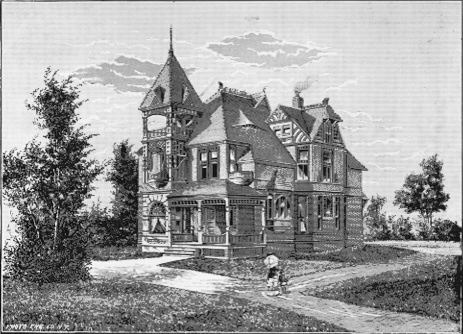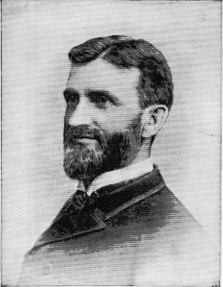|
the men returned to the front, reaching Knoxville in
March, 1864, participating in the Atlanta campaign under
Sherman, being a part of the 3d Brigade, 3d Division, 4th
Army Corps. The 19th Ohio was "in" at New Hope Church, at
Kenesaw, Peach Tree Creek, the crossing of the
Chattahoochie, the engagements about Atlanta, Jonesboro,
Lovejoy's Station, and other engagements of lesser note, in
that 100 days campaign of constant fighting. During this
campaign Col. Manderson commanded a demi-brigade composed of
the 9th Kentucky, 19th Ohio, and 79th Indiana. On the 2nd of
September, 1864, as a result of a terrific charge at
Lovejoy's Station on the enemy's rifle pits, they were
carried and the encounter was so furious as to carry the
troops forward upon the main line of the enemy's works. The
right and left supports of Manderson's demi-brigade gave
way, and it was while Colonel Manderson was engaged in
directing the charge upon these rifle pits, so that they
could be made a new advance line for the federals, that he
was severely wounded in the spine. His loss here was 70 men
killed and wounded. The disability from this wound was so
great in resulting consequences that he was rendered unfit
for service, and he tendered his resignation March 17, 1865,
which was not accepted, however, until he was brevetted a
Brigadier General of volunteers for "gallant, long continued
and meritorious services." General Manderson returned home
to Canton in April, 1864, and resumed the practice of the
law, forming a partnership with Judge Seraphin Meyer. The
firm secured a large practice, and Manderson was twice
elected to the office of prosecuting attorney. In 1867 he
came within one vote of receiving the nomination for
Congress in the Republican convention for the then large
17th Congressional District, now represented by Major
McKinley, which then gave 5,000 Republican majority. General
Manderson removed to Omaha in Nov. 1869, and formed a
partnership with Hon. James W. Savage, which continued for
six years and until the latter went upon the bench.
Manderson remained alone in his profession until 1880, when
he formed the partnership of Manderson & Congdon,
which 
RESIDENCE OF LOUIS SCHROEDER. continued successfully until the former's election to the Senate. For six years, during the terms of Mayors Wilbur, Chase and Boyd, General Manderson was city attorney of Omaha. In 1871, and again in 1874, he was elected by both political parties and without opposition, a member of the Constitutional Convention. He served for two years as president of the Nebraska State Bar Association and has for several years been one of the executive committee of the American Bar Association. At the legislative session in 1883, Gen. Manderson was elected to the United States Senate for six years, as a Republican, succeeding Hon. Alvin Saunders. Gen. Manderson, without the arts of the demagogue in politics, is a true representative of his party, in its ideas, policy and progressiveness. Conservative, prudent and sagacious, he is also painstaking, vigilant and faithful. He has been mentioned as a candidate for VicePresident, an honor unsought, and a compliment to his devotion to the best interests of his State and of the great West. His influence at Washington is recognized, and exceeds that usually allotted to a Senator during his first term. He is a member of the Committee on Military Affairs, and of the Committee on Territories; and upon the death of the veteran Senator Anthony, he was made chairman of the Committee on Printing. His term as Senator will expire March 4, 1889. mendation that Iler be treated leniently, in consideration of his having prevented Bouve from killing Mrs. Taylor. The verdict was approved by the crowd, who decided that the Vigilance Committee should finally dispose of the case. The Vigilance Committee, composed of well-known citizens, accordingly proceeded at midnight to the jail, and overpowering Bouve, hanged him to a beam in the hall. He was a noted desperado, and was credited with |
|
having committed several murders in the
West. He no doubt deserved his fate. Iler was set free, and
ordered to leave the city. He became a Union soldier, served
through the war, and made a good record.
the Missouri river, north of the city. It was identified as that of Isaac H. Neft, and it was shown at the coroner's inquest that he had been murdered. The corpse had been loaded down with logchains and dumped into the river. Neff had recently come to Omaha from Denver, in company with Tator and several teams and empty wagons. Two or three of the wagons were found near Sulphur Springs. It was also discovered that Tator had started for Denver with one of Neff's teams and wagons. Circumstances went to show that he was the murderer. He was overtaken in Colfax county, and brought back to Omaha, where he was tried, convicted and sentenced to death. The case was prosecuted by Charles H. Brown and Judge Lake, and defended by Hon. A. J. Poppleton and William A. Little. The object of the murder was robbery, it being supposed that |
|||||||||
|
|
|
|

